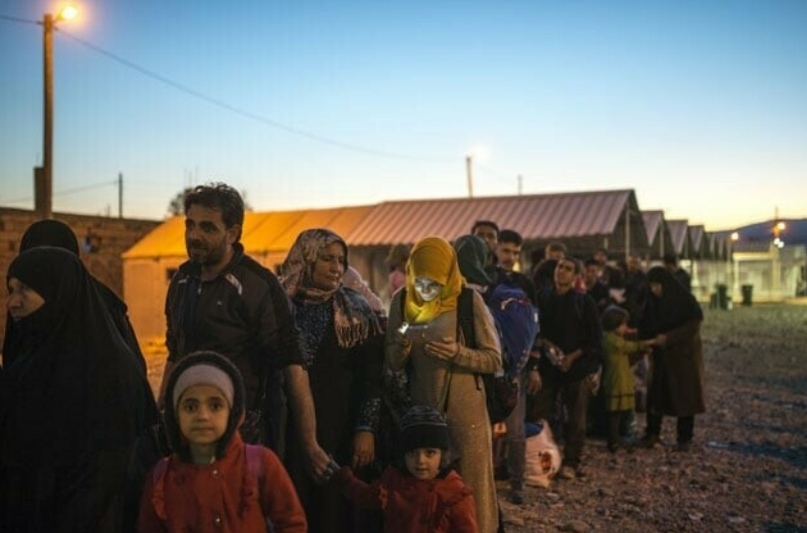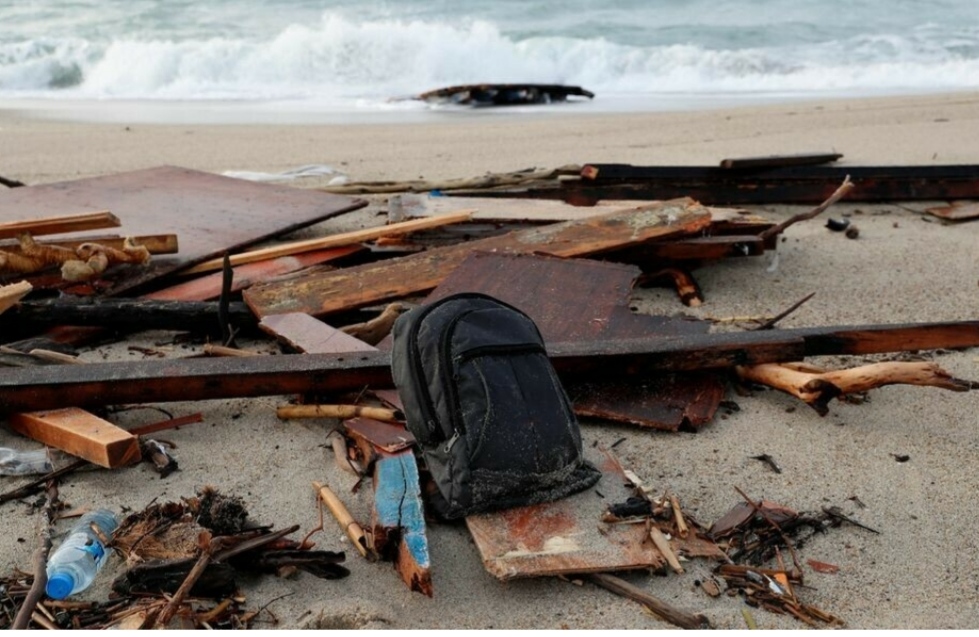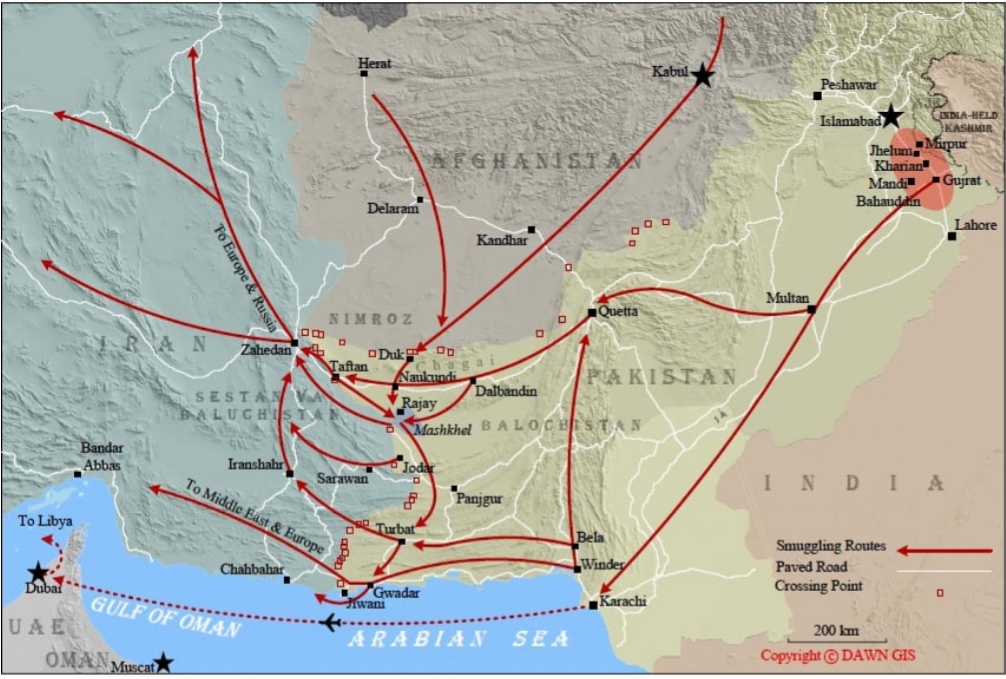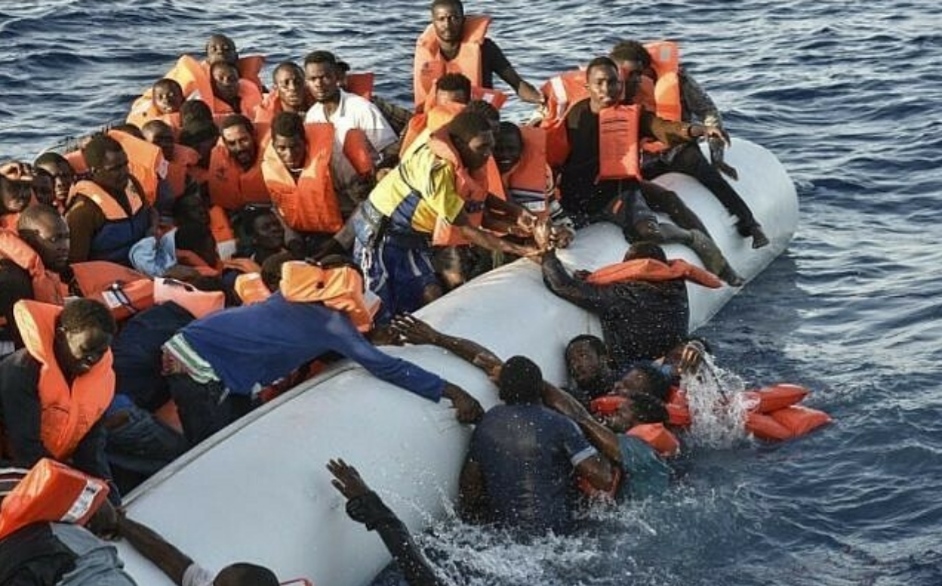Everyone wants to leave Pakistan
Weeks after a fishing boat, carrying up to 750 refugees, capsized off the coast of Greece, the Federal Investigation Agency (FIA) in Pakistan has gone into overdrive, announcing the arrests of dozens of ‘human smugglers’ and promising to disrupt the entire network of agents and operators involved in the illegal business.
But why has it taken so many deaths for the authorities to spring into action? Why did so many lives have to perish for the law enforcement agencies to realise this is a problem? Most importantly, why are Pakistanis willing to walk (and swim) through the valley of death to reach ‘greener pastures’?
Everybody wants to escape
The issue of migration — whether legal or otherwise — has long existed in Pakistan. Of late, however, there has been a huge uptick in people wanting to leave for better livelihoods due to a precarious, high-inflation economy, coupled with rising unemployment, as well as a coercive and unstable political climate.
“Pakistan’s economic and political conditions have deteriorated greatly,” said Hassan Zaidi, a filmmaker who has closely documented the migrants’ journey across multiple routes and borders. “It [stability] is directly proportional to legal and illegal [migrations], both of which are [currently] overloaded. The Canadian embassy doesn’t have time, European embassies don’t have time; it’s so difficult to get an appointment at the US embassy. Everyone wants to get out.”
According to the Displacement Tracking Matrix of the International Organisation for Migration, 4,065 migrants have arrived in Europe from Pakistan by land and sea this year alone. Over the last five years, 273,331 Pakistanis were deported from countries across Europe, according to the FIA.

Migrants and refugees wait for a train heading to Serbia from the Greek-Macedonian border near Gevgelija — AFP
Moving towards greener pastures
“Youngsters mostly from rural areas are motivated by seeing people in their surroundings, who after years of struggle, managed to make ‘kothis’ (bunglows),” explained Zaidi.
Almost every family in these towns has a member living abroad, he said. Most of these people managed to migrate legally in the 1960s.
These migrations were driven after the construction of Mangla dam by a British firm. The community displaced due to the project was invited to settle in the United Kingdom (UK) when 250 villages in Mirpur were flooded. Mirpur is still known as ‘mini England’.
Again in 1967, the British invited thousands of Pakistanis to settle in the UK. These Pakistanis served as textile mill workers, domestic workers and nurses addressing UK’s labour shortages in textile mills and health departments following the second World War.
Ali Nobil Ahmad, in his book Masculinity, Sexuality and Illegal Migration, posits that masculinity plays a key role in men attempting treacherous journeys despite knowing the dangers.
Adding to the argument, Zaidi said that many attempt it because of the belief that they would rather die trying to make the lives of their family better, than sit idle and do nothing.
According to the findings of the International Center for Migration Policy Development (ICMPD), young migrants also tend to ignore the warnings from tragic incidents believing them to be cases of “individual bad luck or bad decision making”. Moreover they see unemployment (long-term) as a bigger problem than the “short-term risks to their well-being on the irregular migration journey”.
When asked TikTok spoke about the videos and the platform’s actions to curtail the advertisement of illegal migration and human trafficking, TikTok’s spokesperson said that the company has strict community guidelines and are rolling out further changes to combat the platform’s misuse.
An unsuccessful legislation
In 2018, the Government of Pakistan introduced two laws to curtail the illegal movement of migrants — the Prevention of Trafficking in Persons Act and the Prevention of Smuggling of Migrants Act. The latter legislation decriminalised migrants and entailed punishment of up to 14 years in prison for the agents.
However, these laws have largely been unable to deter both the traffickers and the migrants who are desperate to get to Europe.
This legislation also isn’t new in nature. Before these laws, “there were criminal laws prohibiting these activities”, said Furkan Ali, a lawyer closely looking at the migrant crisis. “Like most things in Pakistan, I don’t think the new legislation has had any impact,” he added. “This is not a problem that stems from a lack of legislation.”
Instead, the issue arises from people’s needs, desires and motivation to have a chance at better living conditions. “You cannot stop someone’s desire to move abroad. How can we argue with [someone like] Shahida Raza who has lost her job and husband; she is failed by the economic system, failed by the justice system and failed by society. She will try to leave. We can’t stop that,” said Ali. “All you can do is stop the people who are trying to help her with that illegally and taking money for it.”
FIA Anti-Human Trafficking and Smuggling Wing Director Muhammad Alam Shinwari told Dawn.com that in the past few years, thousands of agents have been arrested for facilitating the illegal migration of people from Pakistan.
He added, however, that in most of these cases, the victims “resile from their statements”, rendering it impossible to prosecute them. The other challenge is that people now travel with valid visas to the first location, which makes it difficult to catch them. “If we ask too many questions, it becomes a human rights law violation.”
The FIA has 10 police stations across Pakistan where such cases can be registered. They have also updated and tightened the border management system. “At airports, we have started questioning people and stopping travellers who look like victims,” he said.
Similarly, Ali shared that the “FIA has been making arrests and are in touch with airlines to get information about people who’ve travelled to Libya from Pakistan […] and who is booking [tickets] for them.”
Libya is a point of focus “because people who get on these boats, they go from Northern Africa because that is the shortest distance [to the tip of Italy].”

Wreckage of a shipwreck in southern Italy which left dozens of migrants dead after the boat in which they were travelling smashed onto the rocks, in Cutro, Italy. — Reuters/Remo Casilli
“Immigration staff has been given training and new equipment to deal with these issues. Our systems have been connected to NADRA and other databases. There is an intelligence task force consisting of different agencies, especially on our border points, to block people going through land and sea routes,” said Shinwari.
Only recently, the FIA registered 149 cases and arrested 41 human smugglers in connection with the latest Greece boat tragedy in which hundreds of Pakistanis lost their lives.
“FIA can’t spring into action when there is a tragedy like this,” Ali stressed, “It needs an ongoing strategy to get to the human traffickers.”
The migrants and refugee crises are not exclusively Pakistan’s problem. It is, rather, a global issue. With so many countries, transnational actors across borders involved, it becomes a complicated and complex web that is hard for any singular agency to unwind.
This phenomenon can also be observed in the numerous videos on TikTok, in which friends of illegal immigrants can be seen cheering them despite knowing the dangers. The men attempting this journey are termed to be courageous and brave sons of their parents.
Previously, agents who used to convince young people to migrate, used to be highly reputed persons of the area coming into contact with people through word of mouth. Now with the advent of social media, TikTok and other similar social media platforms are being used by agents to market their services.
For instance, many immigrants on TikTok have made testimonials for ‘General Musa’, thanking him for helping them reach Europe.
The routes
Several routes are used to smuggle people through Balochistan (see map). According to journalist Akbar Notezai, who has reported extensively on the subject, one route goes from Karachi via the RCD Highway towards Taftan, then onward to Zahedan (capital of the Iranian province of Sistan-Baluchistan) to the Turkish border and beyond. Another runs from Karachi to Sistan-Baluchistan via Lasbela and Kech districts. Yet another goes from Quetta towards western Balochistan to the border towns of Taftan, Mashkel or Rajay.

Commonly used routes by irregular migrants. — Map: Dawn GIS
Taking the sea route means first travelling to Gwadar district via the Coastal Highway from Karachi, which allows people to skirt the dangerous, insurgency-hit areas further inside Makran.
After Iran erected a 15-foot high wall along its border with Afghanistan’s Nimruz province, Afghans also began to get smuggled out via Balochistan. Duk, a deserted area near the Pak-Afghan border in Chaghi, is the point where they cross over into Pakistan. From Duk, the Afghans are taken 100kms away in the direction of Naukundi along katcha roads and onward to Mashkel or Rajay, which are their gateway into Iran and onwards to Turkey and Europe.
For Pakistanis from Punjab, who seek to cross the border illegally, Quetta is the first port of call. Agents arrange for them to travel to the border, usually via bus through the western parts of the province. Kech, Gwadar and Panjgur districts in the restive Makran region towards the south were once much frequented by migrants, but no longer, because they are most likely to encounter Baloch insurgents there. And these outlaws are particularly hostile towards Punjabis.
In fact, a survey by the International Organisation for Migration (IOM) in 2021 found that 46 per cent of people trying to migrate are in the age group of 25-34 and 80 pc hail from towns of central Punjab — Mandi Bahauddin, Gujrat and Gujranwala — and 10 pc from Khyber Pakhtunkhwa (KP).
Pakistani agents are mostly only concerned with the things within the country and once they get migrants across the Pakistani border, they are handed over to agents of that respective country for the journey ahead. This also hinders the local authorities from stopping the subsequent developments as their scope of control, policing and prosecuting is limited to local boundaries.
To curb this problem, the FIA has signed multilateral and bilateral agreements with different countries to exchange information — and their offices exist in countries such as Iran, Oman, Greece, Spain and the UK. The coordination mechanism between liaison officers of different countries help them share data with each other. However, the effectiveness of these exchanges remains questionable.
On the other hand, the network of traffickers is much better organised and not just limited to illegal migration. It also deals with money laundering, narcotics and other forms of smuggling in Pakistan, providing similar routes for these acts. “These are set routes, not only for [the movement of] people but also things come and go [through them],” said Zaidi. The unregulated inflow of Iranian petrol and diesel is one such example.
Air routes are now commonly used through Iran, Libya and Dubai. The agent in Pakistan helps people get legal visit visas and tickets for the first location, after which they are sent over to the next agent in the chain. The latter would help these legal visitors get onto small boats which would eventually help them land in Europe.
“The easiest entry into Europe is through Italy and Greece, where an immigrant can reach via boats, circumventing the land borders,” said Ali.
Ali added that seas, compared to the land, have lesser control since the beaches where immigrants set ashore are not manned well and once an immigrant is on foreign soil, they are likely to be granted refugee status.
These boats are small, often filled beyond their capacity and their engines fail keeping the people onboard floating in the sea for days or months, making survival next to impossible.

Migrants and refugees panic as they fall in the water during a rescue operation off the Libyan coast in the Mediterranean Sea — AFP/Andreas Solaro
It’s not that simple
On a global scale, Pakistan is a tiny part of this broader issue. Human trafficking is a highly-profitable and lucrative business and happens in various regions of the world. “I don’t look at it at all as a Pakistani problem. It has become a Pakistani problem only because of the events from a few weeks ago — since 400 people died. The international media is paying attention only now sadly,” said Ali.
He added that the majority of migrants globally consists of people fleeing war and conflict zones such as Ukraine and Syria. Most people who leave Pakistan in irregular ways (except religious minorities such as Hazaras) are, hence, categorised as ‘economic refugees’.
“The people escaping war are the ones numbering in the hundreds of thousands. They are the ones Europe is really concerned about,” said the lawyer. Having said that, Pakistan must not look at the crisis in isolation and needs a broader strategy that goes beyond laws to address the multiple-layered problem.
The categorisation of migrants is important to note since the 1951 Refugee Convention states that “a refugee should not be returned to a country where they face serious threats to their life or freedom”. It also contains rights provided to refugees such as the right to not be punished for irregular entry, right to non-discrimination, right to housing, property ownership, freedom of movement, provision of identification documents, education, freedom to practice their religion and pursuing a profession.
Moreover, the Convention’s 1967 Protocol expanded it “to apply universally and protect all persons fleeing conflict and persecution”.
The ‘refugee’ defined by the Convention is someone who “owing to well-founded fear of being persecuted for reasons of race, religion, nationality, membership of a particular social group or political opinion, is outside the country of [their] nationality and is unable or, owing to such fear, is unwilling to avail [themselves] of the protection of that country; or who, not having a nationality and being outside the country of [their] former habitual residence, is unable or, owing to such fear, is unwilling to return to it.”

Participants hold flags and a banner during an anti-immigration rally organised by the far-right party in Slovakia. — AFP
On a simplistic glance, the migrants leaving Pakistan for better living conditions may not appear to be qualified as a refugee under the Convention, however, “economic migrants are very rarely just economic migrants,” pointed out Ali. “If you’re forced to leave a country, there’s a mixture of reasons, so it’s not so easy to say that ‘this person isn’t a refugee under the refugee convention, they are only an economic migrant.”
This intersectional approach helps us understand that often the dearth of economic opportunities are linked to security, well-being and various other precarities. For example, the chronic climate crisis in recent years has forced thousands to be internally and externally displaced. Climate refugees don’t necessarily always leave a place due to immediate threats to their lives but are forced to do so for a myriad of reasons.
Understanding the nuances of the illegal migration crisis shifts the focus from the need for legislation to addressing the root causes such as the improvement of living conditions and having avenues of productive work and leisure activities. Spreading awareness is also paramount about the dangers of the journey, however, most people are already aware of the risks, albeit to a certain degree.
According to Zaidi, many immigrants after hearing about the precarious journey want to turn back. However, the agents demand money for sending them back the same illegal way and most of these migrants, by the time they realise the dangers, have been made to burn their identity documents.
On the contrary, Shinwari said that people who wish to be deported back to the country are facilitated by FIA offices and Pakistani embassies. He said that many people in the past have willingly opted to be deported.
The FIA has increased public awareness campaigns in the 21 districts where trafficking is most prevalent. To curb ads on social media, they have requested the cybercrime wing and public representatives to look into the issue. “Migration has been here for decades. People will only stop if they are given the right opportunities. Otherwise, people will go. If society as a whole discourages this, only then it can be stopped.
“People now sell their valuables to send their loved ones to these places,” said Shinwari. Echoing his stance, Zaidi also believes that making employment and living conditions better is the key to solving the crisis.




